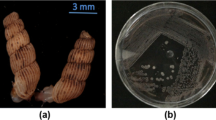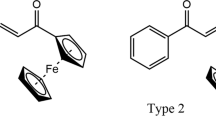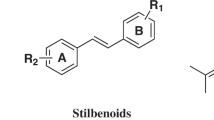Abstract
To investigate the mechanism of action by which farnesol functions as an antibacterial agent and inhibits Staphylococcus aureus growth, the growth rates of S. aureus cultured in farnesol versus S. aureus cultured in farnesol and supplemented with 3-hydroxy-3-methylglutaryl (HMG)-CoA or mevalonate were compared. The investigation was designed to observe whether farnesol affected on the mevalonate pathway by using the intermediate metabolites of the pathway. The resulting growth curves demonstrated that mevalonate reduced the antibacterial activity of farnesol, but HMG-CoA did not inhibit farnesol. These results suggest that farnesol affects the mevalonate pathway. Moreover, farnesol inhibited HMG-CoA reductase activity in an in vitro enzymatic assay.
Similar content being viewed by others
Introduction
Nosocomial infections are a serious problem, and the appearance of pathogenic, antibiotic-resistant bacteria has made it difficult to solve this growing problem. Moreover, many pathogenic bacteria that cause community-acquired infections are also becoming resistant to antibiotics. The existence of resistant community-acquired pathogens makes the problem of antibiotic-resistant bacteria even more complex. Staphylococcus aureus has become resistant to various antibiotics; consequently much effort has been made to identify novel compounds with antibacterial activities that are effective against S. aureus and to analyze their mechanisms of action.
Compounds from plants, such as essential oils, have attracted considerable interest as candidate antibacterial compounds. Many plant compounds have been used as traditional medicines against various pathogens and some have antibacterial activity.
We have studied the antibacterial activity of terpene alcohols with aliphatic carbon chain against S. aureus in detail1, 2, 3 and found that farnesol, which is classified into sesquiterpene alcohol, showed significant antibacterial activity.1 Moreover, farnesol damages bacterial cell membranes.4 We found that the antibacterial effects of farnesol increased when geraniol was added to bacterial suspension of S. aureus. Geraniol does not express the effective antibacterial activity against S. aureus and does not damage the cell membrane of S. aureus effectively.3 It was speculated that the damage of cell membrane was more serious when the antibacterial effects increased if the only mode of action was the damage on the cell membrane. The observation of leakage of K+ ions revealed that the damage of cell membrane was less serious when geraniol was added to bacterial suspension containing farnesol.5 Then we considered that there might be other mode of actions.
Some authors reported the cytotoxicity of farnesol inducing apoptosis by the inhibition of biosynthesis of phosphatidylcholine6 and by degradation of 3-hydroxy-3-methylglutaryl (HMG)-CoA reductase.7, 8, 9 Their HMG-CoA reductases came from Chinese hamster ovary cell, Met-18b-2 cell and HL60 etc. They are class I HMG-CoA reductase. No report has found the effect of farnesol on class II HMG-CoA reductase which S. aureus contains.
In this study, we investigated whether farnesol inhibits bacterial growth by an additional mechanism other than its ability to damage bacterial membranes; specifically, we tested whether farnesol inhibits the mevalonate pathway. The growth rate of S. aureus cultured using the ‘broth dilution with shaking’ method was monitored10, 11 to identify compounds that inhibit the effect of farnesol on S. aureus growth rate. Each compound tested affects a specific metabolic step; therefore we could identify the mode of action of farnesol based on the metabolic role of the compounds that inhibit farnesol.
Materials and methods
Microorganism and reagents
S. aureus FDA209P, was used as the standard strain and was incubated in brain heart infusion broth (Becton, Dickinson and Company, Sparks, MD, USA).
Coagulase-negative staphylococci (S. epidermidis JCM2414, S. warneri JCM2415 and S. xylosus JCM2418) and enterococci (Enterococcus faecalis NBRC3989 and E. faecium NBRC3128) were incubated in brain heart infusion broth. Escherichia coli NIHJ JC2 and Pseudomonas aeruginosa PAO4141 were incubated in Luria-Bertani (LB) broth (Becton, Dickinson and Company).
Farnesol, NADP (NADPH) and HMG-CoA were purchased from Sigma Chemical (St Louis, MO, USA).
Broth dilution with shaking method
The broth dilution with shaking method was described previously,10, 11 and we applied it as follows. The compound to be tested was added, at the indicated concentrations, to 10-ml aliquots of brain heart infusion broth in loosely capped L-tubes without any solubilizing agent or surfactant.
An aliquot (5 μl) of an overnight culture of S. aureus was added to each 10-ml aliquot of brain heart infusion broth to give ∼1 × 105 colony-forming units of S. aureus per ml. Each culture was incubated with shaking at 40 r.p.m. in air for 24 h at 37 °C. The growth of each culture was monitored turbidimetrically. The OD at 660 nm (OD660) was determined with a biophotorecorder (TN1520, Advantech, Tokyo, Japan). Any delay in proliferation could be identified by comparing the growth curve generated from a control culture incubated in the presence of farnesol (5 μg ml−1) with the growth curve from cultures incubated with farnesol (5 μg ml−1) and supplemented with a test compound.
ID50 was calcd from the growth curve obtained.
HMG-CoA reductase assay
The activity of HMG-CoA reductase was determined by monitoring the reductive deacylation of HMG-CoA to mevalonate.12

Assays contained 0.25 mM NADPH, 0.25 mM HMG-CoA, 50 mM NaCl, 1 mM EDTA and 25 mM KH2PO4 (pH 7.5). Protein concentration of crude enzyme added to the assay system was 750 μg ml−1, which was determined by using Bradford assay13 using bovine serum albumin as a standard. Farnesol was added at the concentratin of 80 μg ml−1 and pre-incubated at 37 °C for 1 h and reaction was initiated by adding HMG-CoA and carried out at 37 °C for 1 h. Crude enzyme solution was obtained by sonication of a bacterial suspension and ultracentrifugation (10 500 × g, 1 h, 4 °C). The progress of the reaction was monitored by determining the absorbance of NADPH at 340 nm on a DU-65 spectrophotometer (Beckman, Fullerton, CA, USA). Each assay was run three times. Results are shown as the mean±s.d. Enzymatic reaction without HMG-CoA, which was the substrate, was carried out as a negative control.
Determination of ATP concentration in bacterial cells
The ATP concentration in the bacterial cells was determined with luciferin-luciferase reaction. The intensity of luminescence was measured by Lumimark (Bio-Rad, Hercules, CA, USA). The amount of ATP in the cell was calcd by subtraction of the amount of ATP outside the cell from the all amount of ATP in the bacterial suspension. The ATP measurement without bacteriolytic reagent (DKK-TOA, Tokyo, Japan) gives the amount of ATP outside cell and the measurement with bacteriolytic reagent gives the cell amount of ATP in the bacterial suspension.
Results and discussion
Antibacterial activity of farnesol was observed against some Gram positive and negative bacteria. ID50 of farnesol to S. aureus and coagulase-negative staphylococci, such as S. epidermidis, S. warneri, S. xylosus, was 0.45 and 2.5–4.9 μg ml−1. The growth of staphylococci and enterococci (E. faecalis and E. faecium) was inhibited for more than 24 h at the concentration of 40 μg ml−1.
In the case of E. coli, ID50 was 8.4 μg ml−1 and farnesol did not inhibit the growth for 10 h. Against P. aeruginosa, ID50 was not detected.
These results showed that farnesol expressed the antibacterial activity to Gram positive bacteria, especially to S. aureus as we previously reported,1 but did not inhibit the growth of Gram negative bacteria.
Growth of S. aureus was suppressed for more than 24 h when the concentration of farnesol was 5 μg ml−1. (Figure 1) Addition of mevalonate to S. aureus cultures grown in farnesol inhibited the effects of farnesol on growth rate (Figure 1). Specifically, the delay in proliferation was reduced from 26 to 12 h with a mevalonate concentration of 256 μg ml−1. These results suggest that farnesol inhibited the production of mevalonate, and when the metabolite, mevalonate, was supplied from outside the cell the mevalonate pathway was able to function even in the presence of farnesol. The growth curve of the bacterial suspension containing farnesol and HMG-CoA was similar to the growth curve of the suspension containing farnesol only (data not shown). These results suggest that HMG-CoA did not affect the antibacterial activity of farnesol.
Effect of mevalonate on the inhibitory activity of farnesol on the growth of S. aureus FDA209P. S. aureus FDA209P was incubated in brain heart infusion broth medium containing no reagent (○) or the mixture of farnesol and mevalonate. The concentration of farnesol was 5 μg ml−1 except for in the ‘no reagent’ condition. Mevalonate added was at a concentration of 512 (▵), 256 (□), 128 (⋄), 64 (▪), 32 (▴) or 0 (•) μg ml−1.
These results suggested that farnesol inhibited the mevalonate pathway and that this inhibition resulted in antibacterial activity. Based on the data from the growth curves, farnesol most likely affects a metabolic step upstream of mevalonate synthesis and a step downstream of HMG-CoA synthesis. The production of mevalonate will decrease when the activity of HMG-CoA reductase lower. This induces the inhibition of the growth. The addition of mevalonate might supplement the decrease of the production. It is considered that this leads the recovery of the growth. The metabolic step affected by farnesol is processed by HMG-CoA reductase. To investigate the effect of farnesol on HMG-CoA reductase activity, the absorbance of NADPH at 340 nm was measured to monitor the reductive deacylation of HMG-CoA to mevalonate. (Figure 2).
Absorbance of NADPH at 340 nm (A340) decreased to 0.276 (s.d.=0.045) in these extracts in the absence of farnesol. In contrast, A340 was 1.457 (s.d.=0.047) in the presence of farnesol, similar to that of the negative control, which was the condition without the substrate (1.454 (s.d.=0.010)). These results indicated that farnesol inhibited the activity of HMG-CoA reductase.
It is predicted that the rate of consumption of ATP in the bacterial cell is reduced when the mevalonate pathway is inhibited at the mevalonate synthesis step because the many ATP consumption step is located at the down stream of the mevalonate synthesis step. Farnesol delayed the onset of ATP consumption and the addition of mevalonate eliminated this delay (Figure 3). These results supports the conclusion that farnesol inhibits HMG-CoA reductase.
This study revealed that farnesol inhibited the growth of S. aureus by inhibiting HMG-CoA reductase. Because farnesol inhibits growth of S. aureus by two distinct mechanisms—inhibition of HMG-CoA reductase and damage to the cell membrane, S. aureus may not readily develop resistance to farnesol.
HMG-CoA reductase of S. aureus is classified as class II reductase, whereas that of mammalian cell is classified as class I.12, 14 The results of this study revealed that farnesol inhibited class II HMG-CoA reductase. Statin is known to inhibit HMG-CoA reductase. However, pravastatin did not inhibit the growth of S. aureus (data not shown). Taken together, these results suggest that statins, such as pravastatin, affect class I HMG-CoA reductase but do not affect class II HMG-CoA reductases. Some authors reported that farnesol affected class I HMG-CoA reductase.6, 7, 9 Therefore, farnesol may affect both class I and II HMG-CoA reductases by a mechanism that differs from that of statin. The elucidation of the mode of action of farnesol may contribute the development and use of the novel medicines that inhibit the mevalonate pathway.
References
Hada, T. et al. Inhibitory effects of terpenes on the growth of Staphylococcus aureus. Nat. Med. 57, 64–67 (2003).
Inoue, Y. et al. Biphasic effects of geranylgeraniol, teprenone and phytol on the growth of Staphylococcus aureus. Antimicrob. Agents Chemother. 49, 1770–1774 (2005).
Togashi, N., Hamashima, H., Shiraishi, A., Inoue, Y. & Takano, A. Antibacterial activity against Staphylococcus aureus of terpene alcohols with aliphatic carbon chains. J. Essent. Oil Res. 22, 263–269 (2010).
Inoue, Y. et al. The antibacterial activity of terpene alcohols on Staphylococcus aureus and their mode of action. FEMS Microbiol. Lett. 237, 325–331 (2004).
Togashi, N., Inoue, Y., Hamashima, H. & Takano, A. Effect of two terpene alcohols on the antibacterial activity and the mode of action of farnesol against Staphylococcus aureus. Molecules 13, 3069–3076 (2008).
Correll, C. C., Ng, L. & Edwards, P. A. Identification of farnesol as the non-sterol derivative of mevalonic acid required for the accelerated degradation of 3-hydroxy-3-methylglytaryl-coenzyme A reductase. J. Biol. Chem. 269, 17390–17393 (1994).
Meigs, T. E., Roseman, D. S. & Simoni, R. D. Regulation of 3-hydroxy-3-methylglutaryl-coenzyme A reductase degradation by the nonsterol mevalonate metabolite farnesol in vivo. J. Biol. Chem. 271, 7919–7922 (1996).
Miquel, K., Pradines, A., Terce, F., Selmi, S. & Favre, G. Competitive inhibition of choline phosphotransferase by geranylgeraniol and farnesol inhibits phosphatidylcholine synthesis and induces apoptosis in human lung adenocarcinoma A549 cells. J. Biol. Chem. 273, 26179–26186 (1998).
Flach, J., Antoni, I., Villemin, P., Bentzen, C. L. & Niesor, E. J. The mevalonate/isoprenoid pathway inhibitor Apomin (SR-45023A) is antiproliferative and induces apoptosis similar to farnesol. Biochem. Biophys. Res. Comm. 270, 240–246 (2000).
Arai, T., Hamashima, H. & Sasatsu, M. Inhibitory effects of fatty acids, purified camellia oil and olive oil on the growth of Staphylococcus aureus. Jpn. J. Chemother. 44, 786–791 (1996).
Matsumoto, Y., Hamashima, H., Shiojima, K., Sasatsu, M. & Arai, T. The antibacterial activity of plaunotol against Staphylococcus aureus isolated from the skin of patients with atopic dermatitis. Microbios 96, 149–155 (1998).
Wilding, E. I. et al. Essentiality, expression, and characterization of the class II 3-hydroxy-3-emthylglutaryl coenzyme A reductase of Staphylococcus aureus. J. Bacteriol. 182, 5147–5152 (2000).
Bradford, M. M. A rapid and sensitive method for the quantitation of microgram quantities of protein utilizing the principle of protein-dye binding. Anal. Biochem. 72, 248–254 (1976).
Hedl, M., Tabernero, L., Stauffacher, C. V. & Rodwell, V. W. Class II 3-hydroxy-3-methylglutaryl coenzyme A reductases. J. Bacteriol. 186, 1927–1932 (2004).
Acknowledgements
We thank Satomi Kaneko and Misaki Ohashi for useful suggestions on the HMG-CoA reductase activity assay.
Author information
Authors and Affiliations
Corresponding author
Ethics declarations
Competing interests
The authors declare no conflict of interest.
Rights and permissions
About this article
Cite this article
Kaneko, M., Togashi, N., Hamashima, H. et al. Effect of farnesol on mevalonate pathway of Staphylococcus aureus. J Antibiot 64, 547–549 (2011). https://doi.org/10.1038/ja.2011.49
Received:
Revised:
Accepted:
Published:
Issue Date:
DOI: https://doi.org/10.1038/ja.2011.49
Keywords
This article is cited by
-
In vitro bioactivities and gastrointestinal simulation validate ethnomedicinal efficacy of five fermented kodo-based Himalayan traditional drinks and bioaccessibility of bioactive components
Food Production, Processing and Nutrition (2024)
-
Evaluation of farnesol-induced changes in the haemocyte pattern of red cotton bug Dysdercus koenigii Fabricius (Heteroptera: Pyrrhocoridae)
The Journal of Basic and Applied Zoology (2022)
-
A critical role of mevalonate for peptidoglycan synthesis in Staphylococcus aureus
Scientific Reports (2016)
-
Confocal laser scanning microscopy analysis of S. epidermidis biofilms exposed to farnesol, vancomycin and rifampicin
BMC Research Notes (2012)






